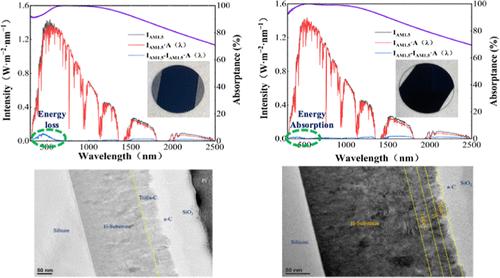当前位置:
X-MOL 学术
›
ACS Photonics
›
论文详情
Our official English website, www.x-mol.net, welcomes your feedback! (Note: you will need to create a separate account there.)
Novel Ultrathin Quasi-Optical Microcavity-Selective Absorber Based on Ti@a-C Cermet for Solar-Thermal Conversion
ACS Photonics ( IF 6.5 ) Pub Date : 2024-06-13 , DOI: 10.1021/acsphotonics.4c00329 Junli Su 1, 2 , Gang Chen 1 , Dingquan Liu 1, 2, 3 , Chong Ma 1 , Ping Xie 1 , Sheng Zhou 1 , Shuguang Wang 1 , Xingyu Li 1 , Haihan Luo 1, 3
ACS Photonics ( IF 6.5 ) Pub Date : 2024-06-13 , DOI: 10.1021/acsphotonics.4c00329 Junli Su 1, 2 , Gang Chen 1 , Dingquan Liu 1, 2, 3 , Chong Ma 1 , Ping Xie 1 , Sheng Zhou 1 , Shuguang Wang 1 , Xingyu Li 1 , Haihan Luo 1, 3
Affiliation

|
The growing attention in solar energy has motivated the development of a highly efficient solar absorber. Under a certain light concentration, increasing the solar spectral absorption of solar absorbers can improve the photothermal conversion efficiency. In this paper, we first designed and prepared a single-layered cermet absorber based on the double-gradient absorption model of refractive index and extinction coefficient with the structure of Ti@a-C cermet layer/a-C protective layer/SiO2 antireflective layer via a magnetron sputtering method. The cermet absorber shows a solar radiation absorption of 96.5% in the ultraviolet, visible, and near-infrared bands of sunlight (300–2500 nm). To further improve the solar radiation absorption of the device, a quasi-optical microcavity structure (QOM) based on cermet–metal–cermet (CMC) was proposed. Due to the synergistic effect of the interband transitions in metal and amorphous carbon (a-C), the plasmon resonance of the metal nanoparticles, and the surface propagating plasmon absorption in the microcavity, the designed and prepared CMC quasi-optical microcavity absorber (CMC-QOMA) reaches a remarkable absorption rate of 97.1% in the solar spectrum band of 300–2500 nm. In addition, the two absorbers are highly insensitive to the incident angle and polarization state of the incident light, demonstrating their high efficiency in practical application scenarios. We also investigated the thermal stability of the absorbers in an atmospheric environment by examining the structure and composition changes before and after annealing. These results indicate that a-C matrix cermet material is an outstanding candidate to improve solar heat conversion and prove that Ti@a-C-based ultrabroadband absorption devices have great potential in solar thermal collection, light detection, and imaging. Furthermore, the proposed device can be fabricated by a simple lithography-free film deposition method, which paves the way for a variety of large-area applications for a-C matrix materials.
中文翻译:

基于Ti@a-C金属陶瓷的新型超薄准光学微腔选择性吸收体用于光热转换
对太阳能的日益关注推动了高效太阳能吸收器的开发。在一定的光浓度下,增加太阳能吸收器的太阳光谱吸收可以提高光热转换效率。本文首先设计并制备了一种基于折射率和消光系数双梯度吸收模型的单层金属陶瓷吸收体,其结构为Ti@a-C金属陶瓷层/a-C保护层/SiO 2 通过磁控溅射方法形成抗反射层。金属陶瓷吸收体在太阳光的紫外线、可见光和近红外波段(300-2500 nm)中显示出 96.5% 的太阳辐射吸收率。为了进一步提高器件的太阳辐射吸收能力,提出了一种基于金属陶瓷-金属-金属陶瓷(CMC)的准光学微腔结构(QOM)。由于金属和非晶碳(a-C)中的带间跃迁、金属纳米颗粒的等离激元共振以及微腔中的表面传播等离激元吸收的协同效应,设计并制备了CMC准光学微腔吸收体(CMC-QOMA) )在300-2500 nm的太阳光谱带内达到了97.1%的显着吸收率。此外,这两种吸收器对入射光的入射角和偏振状态高度不敏感,在实际应用场景中展示了它们的高效率。我们还通过检查退火前后的结构和成分变化来研究吸收剂在大气环境中的热稳定性。 这些结果表明a-C基体金属陶瓷材料是改善太阳热转换的杰出候选材料,并证明Ti@a-C基超宽带吸收器件在太阳热收集、光探测和成像方面具有巨大潜力。此外,所提出的器件可以通过简单的免光刻薄膜沉积方法来制造,这为a-C基体材料的各种大面积应用铺平了道路。
更新日期:2024-06-14
中文翻译:

基于Ti@a-C金属陶瓷的新型超薄准光学微腔选择性吸收体用于光热转换
对太阳能的日益关注推动了高效太阳能吸收器的开发。在一定的光浓度下,增加太阳能吸收器的太阳光谱吸收可以提高光热转换效率。本文首先设计并制备了一种基于折射率和消光系数双梯度吸收模型的单层金属陶瓷吸收体,其结构为Ti@a-C金属陶瓷层/a-C保护层/SiO 2 通过磁控溅射方法形成抗反射层。金属陶瓷吸收体在太阳光的紫外线、可见光和近红外波段(300-2500 nm)中显示出 96.5% 的太阳辐射吸收率。为了进一步提高器件的太阳辐射吸收能力,提出了一种基于金属陶瓷-金属-金属陶瓷(CMC)的准光学微腔结构(QOM)。由于金属和非晶碳(a-C)中的带间跃迁、金属纳米颗粒的等离激元共振以及微腔中的表面传播等离激元吸收的协同效应,设计并制备了CMC准光学微腔吸收体(CMC-QOMA) )在300-2500 nm的太阳光谱带内达到了97.1%的显着吸收率。此外,这两种吸收器对入射光的入射角和偏振状态高度不敏感,在实际应用场景中展示了它们的高效率。我们还通过检查退火前后的结构和成分变化来研究吸收剂在大气环境中的热稳定性。 这些结果表明a-C基体金属陶瓷材料是改善太阳热转换的杰出候选材料,并证明Ti@a-C基超宽带吸收器件在太阳热收集、光探测和成像方面具有巨大潜力。此外,所提出的器件可以通过简单的免光刻薄膜沉积方法来制造,这为a-C基体材料的各种大面积应用铺平了道路。






































 京公网安备 11010802027423号
京公网安备 11010802027423号